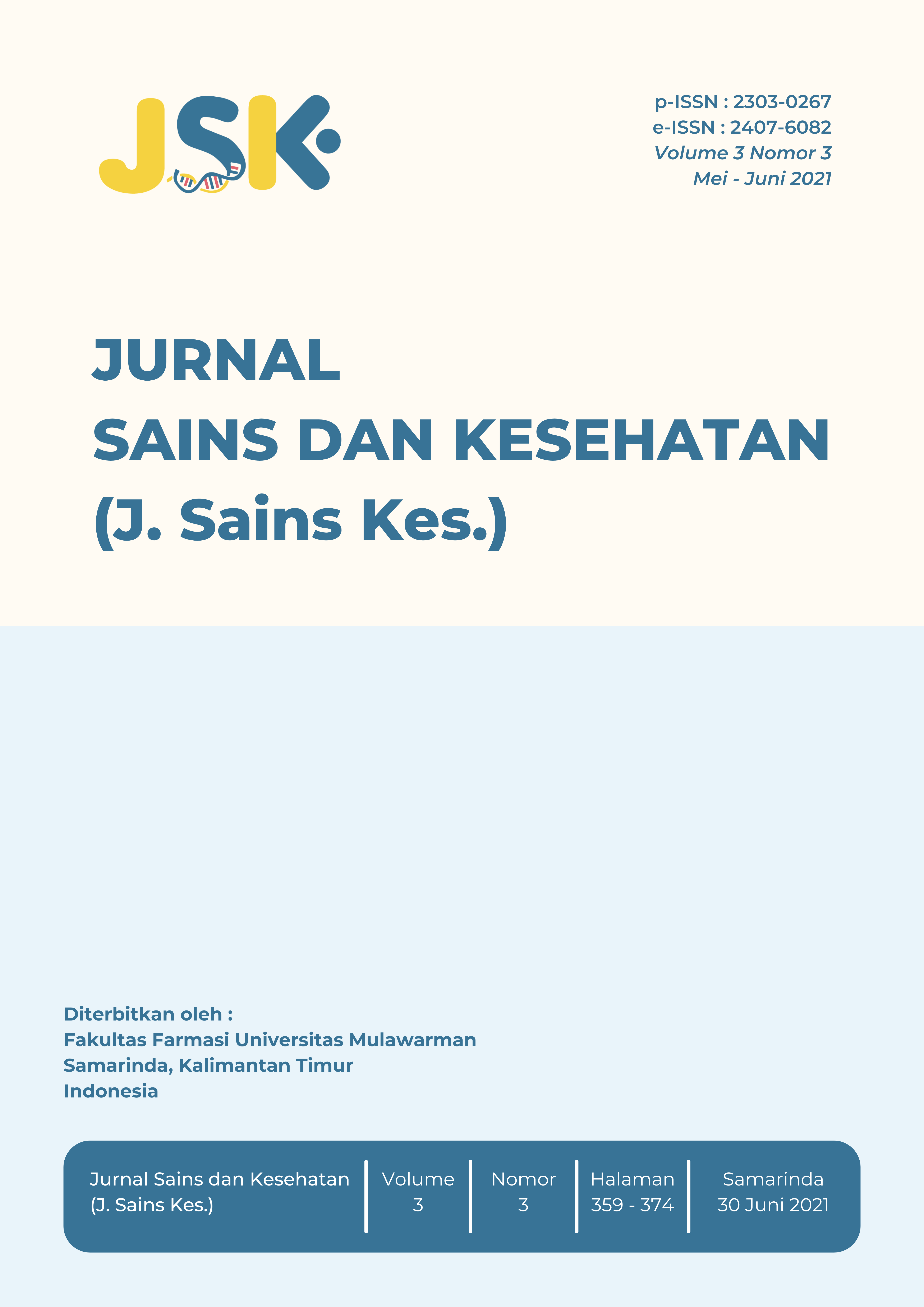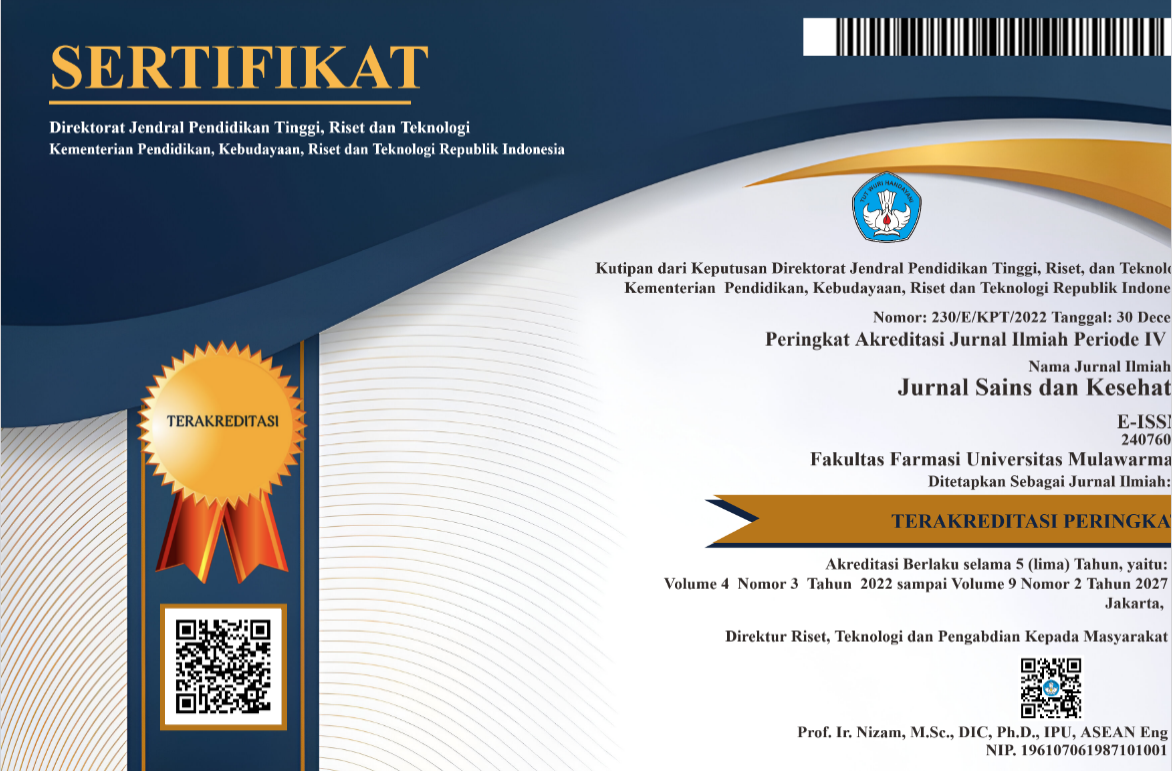Faktor-faktor yang Mempengaruhi Asfiksia Neonatorum: Suatu Kajian Literatur
Factors Affecting Asphyxia Neonatorum: A Literature Review
Keywords:
Asfiksia neonatorum, Pertumbuhan janin terhambat, Preeklampsia, Sindrom aspirasi mekonium, Presentasi bokongAbstract
References
Gillam-Krakauer, M., Gowen Jr, C.W. Birth Asphyxia. [Updated 2020 Aug 30]. In: StatPearls [Internet]. Treasure Island (FL): StatPearls Publishing.
Dharmasetiawani, N. (2008). Asfiksia dan Resusitasi Bayi Baru Lahir. In M. S. Kosim, A. Yunanto, R. Dewi, G. I. Sarosa, & A. Usman (Eds.), Buku Ajar Neonatologi (1st ed., pp. 71–88). Jakarta, Indonesia: Badan Penerbit IDAI..
Lengkong, G. T., Langi, F. L. F. G., Posangi, J. (2020). Faktor-Faktor Yang Berhubungan Dengan Kematian Bayi di Indonesia. Jurnal KESMAS, 9, 41-47.
Kementerian Kesehatan Republik Indonesia. (2020). Profil Kesehatan Indonesia Tahun 2019.
Gupta N. (2016) Antepartum Hemorrhage. In: Gandhi A., Malhotra N., Malhotra J., Gupta N., Bora N. (eds) Principles of Critical Care in Obstetrics. Springer, New Delhi.
Tasew, H., Zemicheal, M., Teklay, G., Mariye, T., & Ayele, E. (2018). Risk factors of birth asphyxia among newborns in public hospitals of Central Zone, Tigray, Ethiopia 2018. BMC Research Notes, 11(1),
Romo, A., Carceller, R., & Tobajas, J. (2009). Intrauterine growth retardation (IUGR): epidemiology and etiology. Pediatric endocrinology reviews : PER, 6 Suppl 3, 332–336.
Sudirman, S., Wicaksono, B., Pariani, S. (2020). Faktor Ibu Yang Mempengaruhi Pertumbuhan Janin Terhambat. Indonesian Journal of Health, 1(1), 13-20.
Lazic Mitrovic, T., Mikovic, Z., Mandic Markovic, V., & Mihailovic, S. (2016). Impact of transient period of metabolic adaptation on perinatal asphyxia in neonates with intrauterine growth retardation. The Journal of Maternal-Fetal & Neonatal Medicine, 30(22), 2665–2670.
Warouw, P. C., Suparman, E., Wagey, F. W. (2016). Karakteristik preeklampsia di RSUP Prof. Dr. R. D. Kandou Manado. Jurnal e-Clinic, 4(1), 375-379.
Kusumaningrum, R. Y., Murti, B., Prasetya, H. (2019). Low Birth, Prematurity, and Pre-Eclampsia as Risk Factors of Neonatal Asphyxia. Journal of Maternal and Child Health, 4(1), 49-54.
World Health Organization. (2018a, February 19). Preterm birth. Retrieved from https://www.who.int/news-room/fact-sheets/detail/preterm-birth
Purwaningsih, Y., Dewi, Y. L. R., Indarto, D., & Murti, B. (2018). Factors Associated with Newborn Asphyxia at Dr. Harjono Hospital, Ponorogo, East Java. Journal of Maternal and Child Health, 03(04), 287–293.
Abdo, R. A., Halil, H. M., Kebede, B. A., Anshebo, A. A., & Gejo, N. G. (2019). Prevalence and contributing factors of birth asphyxia among the neonates delivered at Nigist Eleni Mohammed memorial teaching hospital, Southern Ethiopia: a cross-sectional study. BMC Pregnancy and Childbirth, 19(1)
Simm, A. (2007). Fetal malpresentation. Obstetrics, Gynaecology, and Reproductive Medicine, 17(10), 283–288.
Gray, C. J., Shanahan, M. M. Breech Presentation. [Updated 2020 Aug 11]. In: StatPearls [Internet]. Treasure Island (FL): StatPearls Publishing;
Aslam, H. M., Saleem, S., Afzal, R., Iqbal, U., Saleem, S. M., Shaikh, M. W. A., & Shahid, N. (2014). “Risk factors of birth asphyxia.” Italian Journal of Pediatrics, 40(1), 1-9.
Kosim, M. S. (2009). Infeksi Neonatal Akibat Air Ketuban Keruh. Sari Pediatri, 11(3), 212-218.
Downloads
Published
Issue
Section
How to Cite
Similar Articles
- Caecilia Anggi Raharjo, Novia Fransiska Ngo, Annisa Muhyi, Hubungan Kejadian Skor Apgar Kurang dari 7 dengan Faktor Risiko Ibu dan Persalinan di RSUD Abdul Wahab Sjahranie Samarinda Tahun 2018-2019 , Jurnal Sains dan Kesehatan: Vol. 3 No. 2 (2021): J. Sains Kes.
- Laily Mulyani, Novia Fransiska Ngo, Riries Choiru Pramulia Yudia, Hubungan Obesitas dengan Komplikasi Maternal dan Luaran Perinatal , Jurnal Sains dan Kesehatan: Vol. 3 No. 2 (2021): J. Sains Kes.
- Adhe Restu Ananda, Sanfia Tesabela Messakh, Dary Dary, Gambaran Status Gizi dan Perkembangan Motorik Anak Usia 3-5 Tahun Di Kelurahan Pulutan, Salatiga , Jurnal Sains dan Kesehatan: Vol. 2 No. 4 (2020): J. Sains Kes.
- Adheya Putrindashafa Putrindashafa, Denny J. Rotinsulu, Ika Fikriah, Pengaruh Sikap Higiene Tidur Terhadap Kejadian Insomnia Pada Mahasiswa Universitas Mulawarman , Jurnal Sains dan Kesehatan: Vol. 2 No. 4 (2020): J. Sains Kes.
- Ditya Ayu Natalia, Sugiyarto, Endang Darmawan, Efek Samping Hipoglikemi yang Dialami oleh Pasien Geriatri yang Berisiko Sindrom Metabolik , Jurnal Sains dan Kesehatan: Vol. 4 No. 4 (2022): J. Sains Kes.
- Tyssa Mariyana, Agung Eru Wibowo, Yunahara Farida, Uji Aktivitas Antiketombe dan Penyubur Rambut Kombinasi Ekstrak Daun Jeruk Kalamansi (Citrofortunella microcarpa) dan Ekstrak Biji Kakao (Theobroma Cacao) dalam Sediaan Creambath , Jurnal Sains dan Kesehatan: Vol. 3 No. 5 (2021): J. Sains Kes.
- Bakoh Ambarwati, Gelora Mangalik, Kristiani Desimina Tauho, Status Pertumbuhan Bayi 0–1 Tahun dari Ibu dengan Riwayat Kekurangan Energi Kronis (KEK) Semasa Hamil di Salatiga , Jurnal Sains dan Kesehatan: Vol. 2 No. 4 (2020): J. Sains Kes.
- Dian Fita Lestari, Fatimatuzzahra Fatimatuzzahra, Dwi Dominica, Uji Daya Hambat Bakteri Staphylococcus Aureus Sabun Cuci Tangan Cair Berbahan Arang Aktif Batok Kelapa , Jurnal Sains dan Kesehatan: Vol. 3 No. 2 (2021): J. Sains Kes.
- Rachmaningtyas Setyohartono Putri, Setiawati Setiawati, Joko Setyono, Eman Sutrisna, Hajid Rahmadianto Mardhihusodo, Uji Aktivitas Antibakteri Ekstrak Etil Asetat Terong Ungu (Solanum melongena L.) terhadap Bakteri Staphylococcus aureus , Jurnal Sains dan Kesehatan: Vol. 5 No. 2 (2023): J. Sains Kes.
- Fitri Handayani, Reksi Sundu, Ria Mareta Sari, Formulasi dan Uji Aktivitas Antibakteri Streptococcus mutans dari Sediaan Mouthwash Ekstrak Daun Jambu Biji (Psidium guajava L.) , Jurnal Sains dan Kesehatan: Vol. 1 No. 8 (2017): J. Sains Kes.
You may also start an advanced similarity search for this article.




